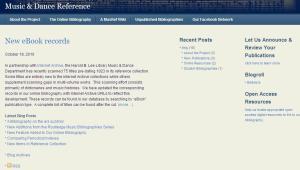One of the resources we didn’t include this year – although we did point to the links on the websites – is Music & Dance Reference Online.
What is it and why mention it? It’s a reference tool of music reference works, initially closely linked to the collections at its home library (Brigham Young University), but by now extending into the world of ejournals, ebooks and websites. So it does two things: it lists traditional printed reference sources and provides an interesting way of discovering free full text resources. It also has additional features such as critiques of individual works, links to reviews and a Wiki with articles, projects and finding aids.
The latest update of content for ebooks includes the results from a partnership between Internet Archive and the Harold B. Lee Library Music & Dance Department, which has recently scanned 75 titles pre-dating 1923 in its reference collection.
On the Pendlebury webpages there are now separate links for ejournals and ebooks, with a little hint on how to find them on Music & Dance Reference online. Although the selection of resources is really quite fascinating, it isn’t that obvious that one can find all listed ejournals by selecting from category and all listed ebooks by selecting from the publication format drop down boxes.
So why use it at all? Wouldn’t Google Scholar or similar give you the same results (and this without the need for search tips)? Or why not just search the Internet Archive directly for ebooks? After all, it includes many more music ebooks than Music & Dance Reference Online. The answer is complicated and a lot has to do with personal preferences. Browsing a good selection of resources can be a very attractive option. Having limited results all relating to reference works can be quite refreshing and time saving. The references refer to a mixture of formats (print, ebook, ejournal, website). And so on… The database also has the added value of being compiled by specialists, including comments and evaluations one may or may not agree with, and it explores the subject of music and dance reference in various ways which gives it just that little extra dimension.
AP


Pingback: MusRef | Ferran Escrivà Llorca